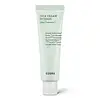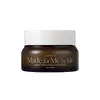What's inside
What's inside
 Key Ingredients
Key Ingredients

 Benefits
Benefits

 Concerns
Concerns

 Ingredients Side-by-side
Ingredients Side-by-side

Centella Asiatica Extract
CleansingCentella Asiatica Leaf Extract
Skin ConditioningCentella Asiatica Root Extract
Skin ConditioningButylene Glycol
HumectantCetearyl Alcohol
EmollientHelianthus Annuus Seed Oil
EmollientCaprylic/Capric Triglyceride
MaskingGlycerin
HumectantCetearyl Olivate
1,2-Hexanediol
Skin ConditioningSorbitan Olivate
EmulsifyingMacadamia Ternifolia Seed Oil
EmollientPanthenol
Skin ConditioningHydroxyethyl Acrylate/Sodium Acryloyldimethyl Taurate Copolymer
Emulsion StabilisingEthylhexylglycerin
Skin ConditioningBeeswax
Emulsion StabilisingArginine
MaskingCarbomer
Emulsion StabilisingAsiaticoside
AntioxidantMadecassic Acid
Skin ConditioningAsiatic Acid
Skin ConditioningCentella Asiatica Oil
AntimicrobialMadecassoside
AntioxidantAllantoin
Skin ConditioningSodium Hyaluronate
HumectantGlycine Soja Oil
EmollientWater
Skin ConditioningPinus Pinaster Bark Extract
AntioxidantCentella Asiatica Extract, Centella Asiatica Leaf Extract, Centella Asiatica Root Extract, Butylene Glycol, Cetearyl Alcohol, Helianthus Annuus Seed Oil, Caprylic/Capric Triglyceride, Glycerin, Cetearyl Olivate, 1,2-Hexanediol, Sorbitan Olivate, Macadamia Ternifolia Seed Oil, Panthenol, Hydroxyethyl Acrylate/Sodium Acryloyldimethyl Taurate Copolymer, Ethylhexylglycerin, Beeswax, Arginine, Carbomer, Asiaticoside, Madecassic Acid, Asiatic Acid, Centella Asiatica Oil, Madecassoside, Allantoin, Sodium Hyaluronate, Glycine Soja Oil, Water, Pinus Pinaster Bark Extract
Water
Skin ConditioningGlycerin
HumectantBetaine
HumectantMethylpropanediol
SolventCyclohexasiloxane
EmollientPentaerythrityl Distearate
EmulsifyingSqualane
EmollientDicaprylyl Ether
EmollientCaprylic/Capric Triglyceride
MaskingCetearyl Alcohol
EmollientCetearyl Glucoside
EmulsifyingAllantoin
Skin ConditioningAdenosine
Skin ConditioningCeramide NP
Skin ConditioningCeramide AP
Skin ConditioningHydrogenated Lecithin
EmulsifyingGlycosphingolipids
EmollientTetraacetylphytosphingosine
Skin ConditioningStearic Acid
CleansingCholesterol
EmollientMangifera Indica Seed Butter
Skin ConditioningButyrospermum Parkii Butter
Skin ConditioningBeta-Glucan
Skin ConditioningHydrolyzed Hyaluronic Acid
HumectantSodium Hyaluronate
HumectantButylene Glycol
HumectantLactobacillus Ferment
Skin ConditioningSaccharomyces Ferment Filtrate
HumectantGalactomyces Ferment Filtrate
HumectantSaccharomyces/Xylinum/Black Tea Ferment
Skin Conditioning1,2-Hexanediol
Skin ConditioningTheobroma Cacao Seed Extract
AntioxidantBifida Ferment Lysate
Skin ConditioningArtemisia Princeps Leaf Extract
Skin ConditioningCentella Asiatica Extract
CleansingLaminaria Japonica Extract
Skin ProtectingEclipta Prostrata Leaf Extract
Skin ConditioningFructooligosaccharides
HumectantSodium Polyacrylate
AbsorbentSodium Stearoyl Glutamate
CleansingDipropylene Glycol
HumectantHydroxyacetophenone
AntioxidantDisodium EDTA
Dextrin
AbsorbentGlyceryl Stearate
EmollientPentylene Glycol
Skin ConditioningEthylhexylglycerin
Skin ConditioningTocopherol
AntioxidantCaprylyl Glycol
EmollientXanthan Gum
EmulsifyingTbhq
AntioxidantJuniperus Virginiana Oil
MaskingCedrus Atlantica Bark Oil
MaskingAmyris Balsamifera Bark Oil
MaskingCopaifera Officinalis Resin
MaskingPogostemon Cablin Leaf Oil
MaskingWater, Glycerin, Betaine, Methylpropanediol, Cyclohexasiloxane, Pentaerythrityl Distearate, Squalane, Dicaprylyl Ether, Caprylic/Capric Triglyceride, Cetearyl Alcohol, Cetearyl Glucoside, Allantoin, Adenosine, Ceramide NP, Ceramide AP, Hydrogenated Lecithin, Glycosphingolipids, Tetraacetylphytosphingosine, Stearic Acid, Cholesterol, Mangifera Indica Seed Butter, Butyrospermum Parkii Butter, Beta-Glucan, Hydrolyzed Hyaluronic Acid, Sodium Hyaluronate, Butylene Glycol, Lactobacillus Ferment, Saccharomyces Ferment Filtrate, Galactomyces Ferment Filtrate, Saccharomyces/Xylinum/Black Tea Ferment, 1,2-Hexanediol, Theobroma Cacao Seed Extract, Bifida Ferment Lysate, Artemisia Princeps Leaf Extract, Centella Asiatica Extract, Laminaria Japonica Extract, Eclipta Prostrata Leaf Extract, Fructooligosaccharides, Sodium Polyacrylate, Sodium Stearoyl Glutamate, Dipropylene Glycol, Hydroxyacetophenone, Disodium EDTA, Dextrin, Glyceryl Stearate, Pentylene Glycol, Ethylhexylglycerin, Tocopherol, Caprylyl Glycol, Xanthan Gum, Tbhq, Juniperus Virginiana Oil, Cedrus Atlantica Bark Oil, Amyris Balsamifera Bark Oil, Copaifera Officinalis Resin, Pogostemon Cablin Leaf Oil
Ingredients Explained
These ingredients are found in both products.
Ingredients higher up in an ingredient list are typically present in a larger amount.
1,2-Hexanediol is a synthetic liquid and another multi-functional powerhouse.
It is a:
- Humectant, drawing moisture into the skin
- Emollient, helping to soften skin
- Solvent, dispersing and stabilizing formulas
- Preservative booster, enhancing the antimicrobial activity of other preservatives
Allantoin is a soothing ingredient known for its protective and moisturizingg properties. Because of this, it is often added to products with strong active ingredients.
Studies show higher concentrations of this ingredient can promote wound healing.
Though it can be derived from the comfrey plant, allantoin is produced synthetically for cosmetic products to ensure purity.
Learn more about AllantoinButylene Glycol (or BG) is used within cosmetic products for a few different reasons:
Overall, Butylene Glycol is a safe and well-rounded ingredient that works well with other ingredients.
Though this ingredient works well with most skin types, some people with sensitive skin may experience a reaction such as allergic rashes, closed comedones, or itchiness.
Learn more about Butylene GlycolThis ingredient is an emollient, solvent, and texture enhancer. It is considered a skin-softener by helping the skin prevent moisture loss.
It helps thicken a product's formula and makes it easier to spread by dissolving clumping compounds.
Caprylic Triglyceride is made by combining glycerin with coconut oil, forming a clear liquid.
While there is an assumption Caprylic Triglyceride can clog pores due to it being derived from coconut oil, there is no research supporting this.
Learn more about Caprylic/Capric TriglycerideCentella Asiatica Extract (Centella) is derived from an herb native to Southeast Asia. It is famous for its anti-inflammatory and soothing properties.
Centella is rich in antioxidants and amino acids, such as Madecassic Acid and Asiaticoside.
Studies show the compounds in centella help with:
The combination of all these properties makes centella effective at soothing, hydrating, and protecting the skin.
Other great components of centella include Vitamin A, vitamin C, several B vitamins, and Asiatic Acid.
Fun fact: Centella has been used as a medicine and in food for many centuries. As a medicine, it is used to treat burns, scratches, and wounds.
Learn more about Centella Asiatica ExtractCetearyl alcohol is a mixture of two fatty alcohols: cetyl alcohol and stearyl alcohol. It is mainly used as an emulsifier. Emulsifiers help prevent the separation of oils and products. Due to its composition, it can also be used to thicken a product or help create foam.
Cetearyl alcohol is an emollient. Emollients help soothe and hydrate the skin by trapping moisture.
Studies show Cetearyl alcohol is non-toxic and non-irritating. The FDA allows products labeled "alcohol-free" to have fatty alcohols.
This ingredient is usually derived from plant oils such as palm, vegetable, or coconut oils. There is debate on whether this ingredient will cause acne.
Due to the fatty acid base, this ingredient may not be Malassezia folliculitis safe.
Learn more about Cetearyl AlcoholEthylhexylglycerin (we can't pronounce this either) is commonly used as a preservative and skin softener. It is derived from glyceryl.
You might see Ethylhexylglycerin often paired with other preservatives such as phenoxyethanol. Ethylhexylglycerin has been found to increase the effectiveness of these other preservatives.
Glycerin is already naturally found in your skin. It helps moisturize and protect your skin.
A study from 2016 found glycerin to be more effective as a humectant than AHAs and hyaluronic acid.
As a humectant, it helps the skin stay hydrated by pulling moisture to your skin. The low molecular weight of glycerin allows it to pull moisture into the deeper layers of your skin.
Hydrated skin improves your skin barrier; Your skin barrier helps protect against irritants and bacteria.
Glycerin has also been found to have antimicrobial and antiviral properties. Due to these properties, glycerin is often used in wound and burn treatments.
In cosmetics, glycerin is usually derived from plants such as soybean or palm. However, it can also be sourced from animals, such as tallow or animal fat.
This ingredient is organic, colorless, odorless, and non-toxic.
Glycerin is the name for this ingredient in American English. British English uses Glycerol/Glycerine.
Learn more about GlycerinSodium Hyaluronate is hyaluronic acid's salt form. It is commonly derived from the sodium salt of hyaluronic acid.
Like hyaluronic acid, it is great at holding water and acts as a humectant. This makes it a great skin hydrating ingredient.
Sodium Hyaluronate is naturally occurring in our bodies and is mostly found in eye fluid and joints.
These are some other common types of Hyaluronic Acid:
Learn more about Sodium HyaluronateWater. It's the most common cosmetic ingredient of all. You'll usually see it at the top of ingredient lists, meaning that it makes up the largest part of the product.
So why is it so popular? Water most often acts as a solvent - this means that it helps dissolve other ingredients into the formulation.
You'll also recognize water as that liquid we all need to stay alive. If you see this, drink a glass of water. Stay hydrated!
Learn more about Water